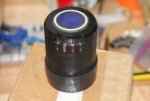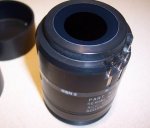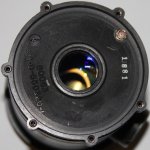So i have been reading and am new to nods and had a few questions to ensure i am understanding what I'm reading. Also I think this will help clarify for us beginners the differences between types of tubes and why not all nods are created equal though they seem to be, and help us understand the questions to ask when comparing say a tnvcc pvs 14 vs an armasight 14 (or even two 14s made by the same company and why ttey are more expensive.
Alot of this will use the pvs 4s as a discussion point. This might be a bit long winded but i figured it beats the heck out of ten posts asking how one nod compares to that nod. The first part is my understanding of just reading a bunch of threads plus my background in photography so if its wrong let me know. The questions come afterwards.
So first f stop. Light gathered is a function of fstop and objective size. so with the pvs 4 the fstop is 1.2 which is numerically low which lets in more light. the large 95 mm objective also has the ability to gather more light from the surroundings. The downside to low fstop is that it creates razor sharp depth of field meaning less of the image is in crisp focus. Now not much manufactures can do with fstop. they need it to be low to gather more light, one way around this is to use a very short focal length which in common terms most people call magnification. The longer the focal length in between the interior lenses the more magnification. the more magnification the more depth of field you have. so as magnification (or more properly focal length) depth of field goes up, This is why Nods are so finicky with focus. and the more magnification you have the more finicky the focus will be.
SNR- signal to noise ratio is a measurement of how much noise there will be in the image if there is not enough light. Noise is affected by two things, one is not enough light. the other is excessive gain, so as light goes down we see noise. as we crank gain it should intitally cure some noise and then move through to increased noise level. Its like iso on a camera. the snr is measuring how well it deals with these lack of perfect conditions. so the higher the number the less noise, and the sweet spot balancing light vs gain will be larger. Noise of course also impacts clarity of image. too noisy you lose detail. so a high snr will be more clear under a wider range of conditions.
QUESTION 1. . so given that understanding. given the same optical quality of the glass, a gen II and Gen III will perform close to one another under perfectly lit conditions(if you have a well balanced even lit ir for the gen II). one needs an ir the other perhaps not as under perfectly lit conditions noise does not come into play. This is why some gen II and gen one look great with ir or a full moon.
Here is where it gets trick for me. The following is from the omni table of classifications. The lp/mm this seems to be an expression of clarity and light gathering capabilities. This is the maximum resolution under perfect conditions.
Tube Contract lp/mm uA/lm @830 @880 SNR Gain> Gain< FOM EBI MTF25 BLR Halo Comments
mx9964 20-40 240 10@850 –– 40000 70000 n/a 2 20 @15 n/a 0 Gen2 PVS-4
mx11620 45 1550 140 70 25 20000 90000 1125 1 20 14 0.7-1.6 Gen3 PVS-4
QUESTION 2: answered
QUESTION 3: With the listed specs for lp/mm in gen two being a range, were earlier more around 20 and later tubes aroudn 40 or were they all somewhere around that range regardless of date of manufacture ANSWERED
QUESTION 4: So back to our previous discussion my understanding then is the large gain on the gen II tube is influenced by a larger tube and the larger objective lens in combination with the low f-stop right? That is why the listed gain is on par with gen iii tubes.
QUESTION 5: GAIN- im a little unsure here but im guessing that the gain listed DOES NOT mean the tube has to be in between the two numbers to pass spec. it means with the gain turned all the way down, for the gen II tube its is 40000 and with it all the way turned up its 70000 give or take correct?
QUESTION 6: Also i notice that there isnt a snr listed for the gen II tube. DO gen II tubes not have snr or is it just not listed? If not what is the snr on the gen ii tube?
QUESTION 7: with Halo i understand that gen II tubes do not suffer from halo correct? or is that just a peculiarity of the pvs 4 gen ii tube? IT IS A PECULIARITY OF THAT TUBE ANSWERED
QUESTION 8: So the similar lpmm (40 on the high end for gen two vs 45 for the gen 3) and slighty higher gain (70 vs 90) is why some people say the gen three is slightly brighter but not much better in resolution?
QUESTION 9 Another seller posted this as the specs for gen three Resolution for the pvs 4 lp/mm 64 S/N 21
Photocathode sensitivity uA/lm@2856K 1800
Sensitivity at uA/lm@830nm 190
Gain fL/fc 40,000-70,000
[email protected]/mm 0.92
[email protected]/mm 0.8
MTF@15lp/mm 0.61
MTF@25lp/mm 0.38
Halo (mm) 1.25
Phosphor P-43
As you can see the gain lower resolution higher and snr lower and halo in between what is posted on this site. Are his numbers incorrect? cj and tnvc generally are on their game so i was thinking maybe he grabbed the wrong tube specs. or is the sellers lpmm of 64 just trying to be expressed in 18mm tube terms?
QUESTION 10: On the pVS 4 tubes the lowest line says acc date. Is this the date of manufacture? ANSWERED
QUESTION 11: FOV is expressed in degrees for nods. now just off the top of my head im thinking degrees times objective size or maybe focal length will tell you how many feet at 100 yards or a thousand yards. Does anyone know that formula?
QUESTION 12: does anyone know the focal length for the pvs 4s?
QUESTION 13: Last one. on the pvs 4s are the gen three tubes just drop in replacements? I thought i saw a thread saying the spacing wasn't right and you had to mill a bit to get the correct focal length? Does TNVC mill their rebuilt gen three pvs 4s, o ram i mistaken?
thanks a bunch (mostly for reading all the way through this)
Alot of this will use the pvs 4s as a discussion point. This might be a bit long winded but i figured it beats the heck out of ten posts asking how one nod compares to that nod. The first part is my understanding of just reading a bunch of threads plus my background in photography so if its wrong let me know. The questions come afterwards.
So first f stop. Light gathered is a function of fstop and objective size. so with the pvs 4 the fstop is 1.2 which is numerically low which lets in more light. the large 95 mm objective also has the ability to gather more light from the surroundings. The downside to low fstop is that it creates razor sharp depth of field meaning less of the image is in crisp focus. Now not much manufactures can do with fstop. they need it to be low to gather more light, one way around this is to use a very short focal length which in common terms most people call magnification. The longer the focal length in between the interior lenses the more magnification. the more magnification the more depth of field you have. so as magnification (or more properly focal length) depth of field goes up, This is why Nods are so finicky with focus. and the more magnification you have the more finicky the focus will be.
SNR- signal to noise ratio is a measurement of how much noise there will be in the image if there is not enough light. Noise is affected by two things, one is not enough light. the other is excessive gain, so as light goes down we see noise. as we crank gain it should intitally cure some noise and then move through to increased noise level. Its like iso on a camera. the snr is measuring how well it deals with these lack of perfect conditions. so the higher the number the less noise, and the sweet spot balancing light vs gain will be larger. Noise of course also impacts clarity of image. too noisy you lose detail. so a high snr will be more clear under a wider range of conditions.
QUESTION 1. . so given that understanding. given the same optical quality of the glass, a gen II and Gen III will perform close to one another under perfectly lit conditions(if you have a well balanced even lit ir for the gen II). one needs an ir the other perhaps not as under perfectly lit conditions noise does not come into play. This is why some gen II and gen one look great with ir or a full moon.
Here is where it gets trick for me. The following is from the omni table of classifications. The lp/mm this seems to be an expression of clarity and light gathering capabilities. This is the maximum resolution under perfect conditions.
Tube Contract lp/mm uA/lm @830 @880 SNR Gain> Gain< FOM EBI MTF25 BLR Halo Comments
mx9964 20-40 240 10@850 –– 40000 70000 n/a 2 20 @15 n/a 0 Gen2 PVS-4
mx11620 45 1550 140 70 25 20000 90000 1125 1 20 14 0.7-1.6 Gen3 PVS-4
QUESTION 2: answered
QUESTION 3: With the listed specs for lp/mm in gen two being a range, were earlier more around 20 and later tubes aroudn 40 or were they all somewhere around that range regardless of date of manufacture ANSWERED
QUESTION 4: So back to our previous discussion my understanding then is the large gain on the gen II tube is influenced by a larger tube and the larger objective lens in combination with the low f-stop right? That is why the listed gain is on par with gen iii tubes.
QUESTION 5: GAIN- im a little unsure here but im guessing that the gain listed DOES NOT mean the tube has to be in between the two numbers to pass spec. it means with the gain turned all the way down, for the gen II tube its is 40000 and with it all the way turned up its 70000 give or take correct?
QUESTION 6: Also i notice that there isnt a snr listed for the gen II tube. DO gen II tubes not have snr or is it just not listed? If not what is the snr on the gen ii tube?
QUESTION 7: with Halo i understand that gen II tubes do not suffer from halo correct? or is that just a peculiarity of the pvs 4 gen ii tube? IT IS A PECULIARITY OF THAT TUBE ANSWERED
QUESTION 8: So the similar lpmm (40 on the high end for gen two vs 45 for the gen 3) and slighty higher gain (70 vs 90) is why some people say the gen three is slightly brighter but not much better in resolution?
QUESTION 9 Another seller posted this as the specs for gen three Resolution for the pvs 4 lp/mm 64 S/N 21
Photocathode sensitivity uA/lm@2856K 1800
Sensitivity at uA/lm@830nm 190
Gain fL/fc 40,000-70,000
[email protected]/mm 0.92
[email protected]/mm 0.8
MTF@15lp/mm 0.61
MTF@25lp/mm 0.38
Halo (mm) 1.25
Phosphor P-43
As you can see the gain lower resolution higher and snr lower and halo in between what is posted on this site. Are his numbers incorrect? cj and tnvc generally are on their game so i was thinking maybe he grabbed the wrong tube specs. or is the sellers lpmm of 64 just trying to be expressed in 18mm tube terms?
QUESTION 10: On the pVS 4 tubes the lowest line says acc date. Is this the date of manufacture? ANSWERED
QUESTION 11: FOV is expressed in degrees for nods. now just off the top of my head im thinking degrees times objective size or maybe focal length will tell you how many feet at 100 yards or a thousand yards. Does anyone know that formula?
QUESTION 12: does anyone know the focal length for the pvs 4s?
QUESTION 13: Last one. on the pvs 4s are the gen three tubes just drop in replacements? I thought i saw a thread saying the spacing wasn't right and you had to mill a bit to get the correct focal length? Does TNVC mill their rebuilt gen three pvs 4s, o ram i mistaken?
thanks a bunch (mostly for reading all the way through this)
Last edited:















